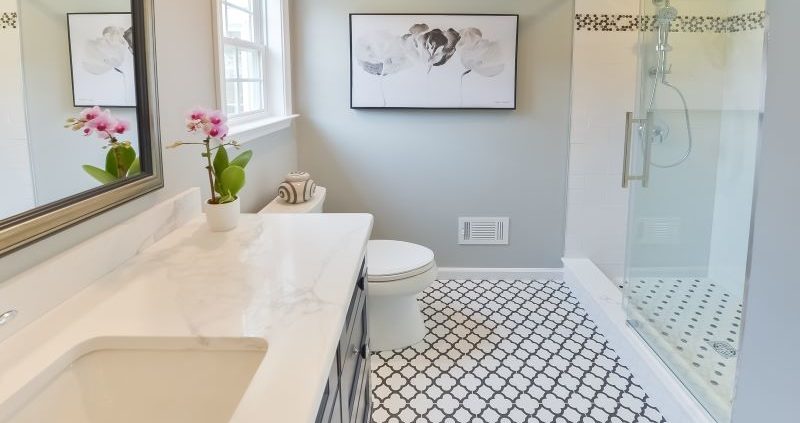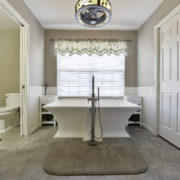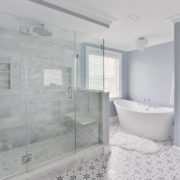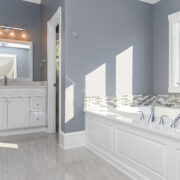Laying Out Beautiful Bathroom Tiling Ideas
Bathroom tiling ideas — laid end to end, the possibilities would easily wrap around the Equator a hundred times over. You’d be hard-pressed to find a bathroom remodeling contractor to take on a project of that scope, but at Ayars, we still like to give our customers plenty of latitude to explore their options.
Like the Equator, bathroom flooring and shower tiling can be a centerline for our design decision-making. Are we going for a more subdued and subtle space, or more vibrant and energizing? Our tile selections will have a major influence not only on the overall look and feel of the room, but on all our other design decisions — vanities, countertops, paint color, fixtures and accessories, and so on (it is one of the first things our in-house designer discusses with our clients before starting a project).
So let’s make sure we get this right, shall we?
Diverse bathroom tiling ideas: colors, textures, and patterns
The number of bathroom tiling ideas out there may be infinite, but when we begin thinking methodically about the dimensions of the room we have to work with, where the tile will be placed, and the aesthetic we are aiming for, we can narrow down those choices pretty quickly.
If you have a specific tile you’ve fallen in love with, all the better — we can use the “star” of the show to help pick out our “supporting cast.”
Color scheme
Softer, cooler, earthier, and more neutral schemes predominate the landscape of modern bathroom design — but that is not to say you can’t opt for a more vibrant or dramatic palette. As a general rule, lighter colors are recommended for smaller bathrooms, while darker ones can help make a large space seem “cozier.”
Whatever the case, once you pick a scheme, stick with it. And don’t forget about tile grout — the more it contrasts with the tile color, the more starkly those tiles will stand out.
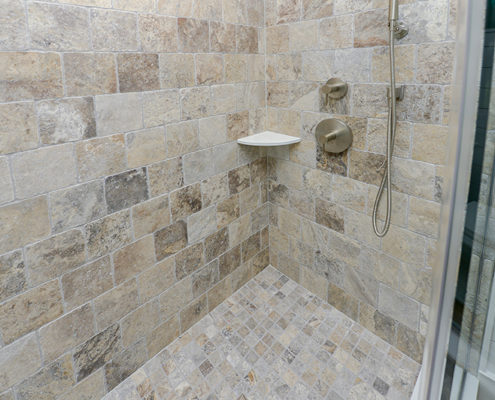
Utilizing the subtleties in shading and sizing, we can create a lot of visual interest using the same tiling.
Texture and finish
Even within a monotone bathroom, a sense of visual interest and dimension can be created by mixing and matching tile textures and finishes. For example, glossy tiles will “pop” when interspersed with matte tiles on a shower wall, implying a pattern even if they are the same color value. For stone or stone-look tiles, we can capitalize on the subtleties of their veining patterns to often stunning results. Sometimes it only takes a little to get a lot!
Size and shape
Tiles can be cut to virtually any shape and size, and in more abstract or artistic applications, you might see several craftily fitted together on the same plane to tell a visual story (e.g. a mosaic mural).
More commonly, though, bathroom tiling comes in square, rectangular, hexagonal, and circular (e.g. penny tiles) shapes, with plenty of opportunities to play with proportions. Large format tiles lend a luxurious look when used as shower tiling, akin to a bathhouse or wet room. Smaller tiles are great used as border elements, and are the practical choice for shower floors: more tiles = more grout = better grip.
Pattern and layout
Now that we’ve sorted out the parts, we’re ready to arrange the whole. Generally speaking, we’ll need tiles to cover the bathroom floor, the shower enclosure (walls and floor), and perhaps a backsplash for the vanity/sink area.
While it’s certainly possible to tile a bathroom from floor to ceiling, this locks you into a particular aesthetic for the long haul, and it’s not so easy to reverse course. The idea here is to impress but not overwhelm — 3 tile types is typically plenty.
The size and shape of the tile will dictate the layout and the particular patterns that can be achieved. Deceptively diverse, rectangular shapes can inspire a plethora of bathroom tiling ideas:
- The classic “subway” pattern
- Herringbone (V-shaped)
- Basketweave (illusion of overlap)
- Modular (mixed and matched sizes)
You might use variations on the same shape in different areas, use different shapes to define different areas or even fit shapes within shapes! Isn’t laying tile fun?
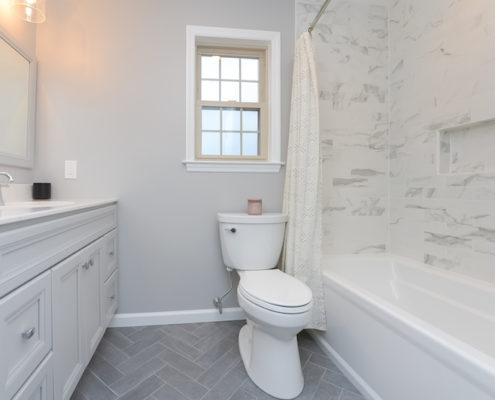
Perpendicularly adjoining at a diagonal, the herringbone tiling pattern is a customer favorite for both bathroom floors and walls. Here its dark coloring is mirrored in the veining accents of the tub/shower surround.
Bathroom tile materials
Now that we’ve discussed design, let’s talk about materials. Bathroom tiles come in a wide assortment of those, but there are definitely a few more popular than others.
Glazed ceramic and porcelain tiles
Glazed ceramic tiles reign supreme in most bathrooms across America, and for good reason — they’re attractive, versatile, durable, and cost-effective. They can be made to mimic a number of other textures and patterns from nature — such as those found in natural stone or wood (e.g. plank tile flooring) — without the headaches that come with trying to maintain those materials.
Porcelain differs from the standard glazed ceramic tile in that the clay is kiln-dried and hardened at higher temperatures, lending to even more enhanced performance. While both options are highly water-resistant, porcelain is the more impervious of the two.
If your bathroom remodel is giving you cold feet, both are superb candidates for an underlying radiant flooring system, as they are excellent conductors of heat.
Natural stone
In terms of beauty and elegance, it doesn’t get much better than natural stone tile — which may come in the form of marble, granite, limestone, and slate. However, a level of caution and care is required with these materials to avoid damage and wear (e.g. avoiding abrasive scrubs on scratch-prone marble, sealing porous limestone and slate), as it is pricier than ceramics.
Glass/mosaic
Multicolored glass tiles can serve as an eye-catching accent as a backsplash, along wall borders, or within custom shower enclosures. It’s not recommended for bathroom flooring, as it’s susceptible to scratches and extremely slippery when wet.
Metal
Metals have also found roles as accent tiles or within mosaics, typically on a wall or partition. It’s available in several tones with shiny, matte, or brushed finishes.
Engineered materials
Manmade materials like linoleum and vinyl still have their supporters, with affordability and stylistic flexibility being the draws. Although linoleum often has a reputation for being cheap or tacky, it actually performs quite well as a bathroom flooring material and is easy to install and replace.
Even more impressive, though, is luxury vinyl tile, aka luxury vinyl plank. Stronger and thicker than conventional vinyl flooring, it may do an even better job at emulating wood or stone than ceramics, and stays warmer and more comfortable underfoot. It’s a favorite among the crew at Ayars.
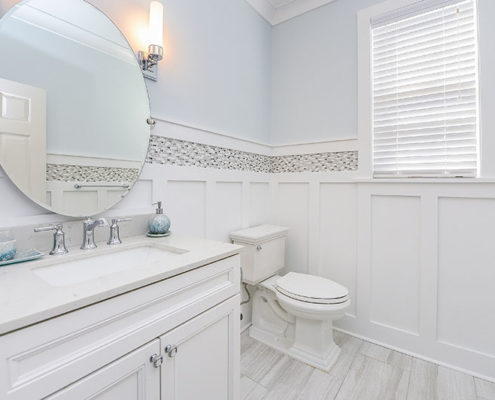
In this powder room, we integrated mosaic tiling into the surrounding custom millwork, with a light-stain wood-look vinyl plank tile for the floors.
Bathroom remodeling inspiration from Ayars
If you’re dreaming of your next bathroom remodel, you’ve come to the right place to allow your imagination to roam free. Browse our portfolio for bathroom tiling ideas and see if your project is a good fit for us in 2023 or beyond.

